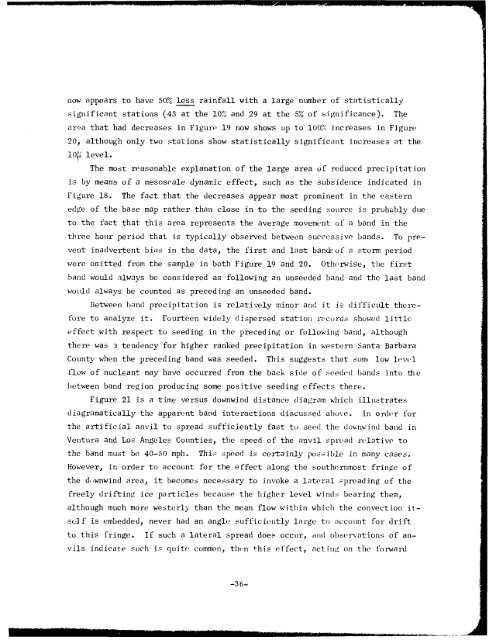pages - The Black Vault
pages - The Black Vault
pages - The Black Vault
- No tags were found...
You also want an ePaper? Increase the reach of your titles
YUMPU automatically turns print PDFs into web optimized ePapers that Google loves.
now appears to have 50% less rainfall with a large number of statisticallysignificant stations (43 at the 10% and 29 at the 5% of significance). <strong>The</strong>area that had decreases in Figure 19 now shows up to 100% increases in Figure20, although only two stations show statistically significant increases at thei0" level.<strong>The</strong> most reasonable explanation of the large area of reduced precipitationis by means of a mesoscale dynamic effect, such as the subsidence indicated inFigure 18.<strong>The</strong> fact that the decreases appear most prominent in the easternedge of the base map rather than close in to the seeding source is probably dueto the fact that this area represents the average movement of a band in thethree hour period that is typically observed between successive bands. To preventinadvertent bias in the data, the first and last bands of a storm periodwere omitted from the sample in both Figure 19 and 20. Otherwise, the firstband would always be considered as following an unseeded band and the last bandwould always be counted as preceding an unseeded band.Between band precipitation is relatively minor and it is difficult thereforeto analyze it. Fourteen widely dispersed station recurds showed littleeffect with respect to seeding in the preceding or following band, althoughthere was 3 tendency for higher ranked precipitation in western Santa BarbaraCounty when the preceding band was seeded. This suggests that som4 low levelflow of nucleant may have occurred from the back side of seeded bands into thebetween band region producing some positive seeding effects there.Figure 21 is a time versus downwind distance diagram which illustratesdiagramatically the apparent band interactions discussed above.In order forthe artificial anvil to spread sufficiently fast to seed the downwind band inVentura and Los Angeles Counties, the speed of the anvil spread relative tothe band must be 40-50 mph. This speed is certainly possible in many cases.However, in order to account for the effect along the southernmost fringe ofthe dwnwind area, it become6 necessary to invoke a lateral spreading of thefreely drifting ice particles because the higher level winds bearing them,although much more westerly than the mean flow within which the convection its(]f is embedded, never had an angle sufficiently large to account for driftto this fringe. If such a lateral spread does occur, and observations of anvilsindicate such is quite common, thin this effect, acting on the forward-36-





![Combat Support in Korea [270 Pages] - The Black Vault](https://img.yumpu.com/49796461/1/190x71/combat-support-in-korea-270-pages-the-black-vault.jpg?quality=85)










